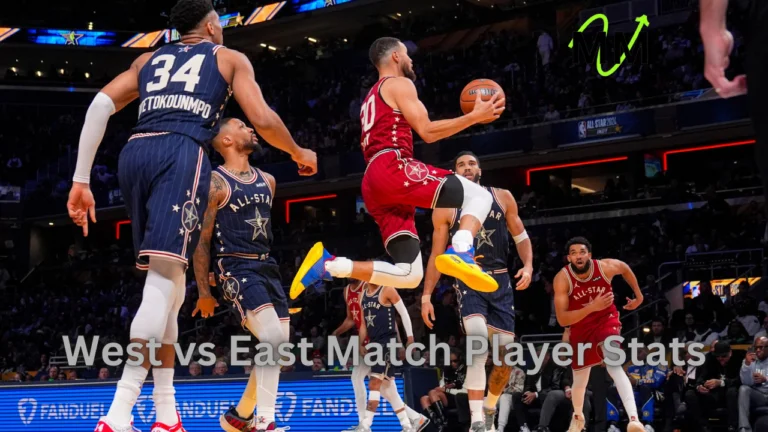Attending the West vs East All-Star game was unforgettable, with thrilling performances and a charged atmosphere.
The West vs East match player stats highlight the top performances in the NBA All-Star Game, showcasing the best players from each conference. This matchup offers valuable insights into player skills and the evolving dynamics of the league.
Stay tuned with us as we dive deeper into the West vs East match player stats and explore the exciting trends, performances, and rivalries that shape the NBA All-Star Game!
What Are “West vs East Match Player Stats”?
The West vs East match player stats refer to the statistics collected during the NBA All-Star Game, focusing on how players from the Western and Eastern Conferences perform. These stats include the usual basketball metrics such as points scored, rebounds, assists, steals, blocks, shooting percentages, and more.
However, when we analyze these stats, it’s not just about who scores the most points; it’s about understanding players’ overall performance in the context of the game’s format, which is often less intense than regular-season games.
Why Are These Stats Important?
The West vs. East match player stats give us insights into the playing styles of players from both conferences. This data helps analysts, coaches, and fans understand performance trends and the evolution of the game.
Whether you are a casual fan or a die-hard NBA supporter, tracking these stats allows you to appreciate the game’s nuances and how player development differs between conferences.
What are the key player stats to watch in the West vs East match?
- Points Scored: Points are a core metric, with higher scoring due to relaxed defense and fast-paced play, revealing which players lead their teams.
- Assists: Assists show playmaking ability, as All-Star games focus on team-oriented basketball and highlight who creates plays for others.
- Rebounds: Rebounds measure a player’s control of the game, even with less focus on rebounding during fast breaks.
- Shooting Percentages: Field goal, three-point, and free-throw percentages highlight a player’s efficiency in the All-Star setting.
- Defensive Stats (Steals & Blocks): Though defense is less emphasized, steals and blocks demonstrate a player’s all-around skills.
What have the trends and patterns been in the West vs. East match over the years?
When we compare West vs East match player stats over the years, a few patterns begin to emerge:
Western Conference Dominance
The Western Conference has historically had a more robust representation in the NBA All-Star Game, especially in the 2000s and 2010s. This dominance has been reflected in the All-Star game results, where players from the West tend to put up higher individual stats and win more often. This trend is due to more elite players in the West, particularly during certain eras with superstars like Kobe Bryant, LeBron James, and Steph Curry.
East’s Resurgence in Recent Years
However, the Eastern Conference has been resurgent in recent years, with players like Giannis Antetokounmpo, Joel Embiid, and Jayson Tatum rising to prominence. This shift has made the West vs. East match player stats more competitive, with games being closer and players from the East contributing more to their team’s overall success.
The Impact of Big Men
The role of big men (centers and power forwards) in the All-Star game has evolved. In earlier years, dominant big men like Shaquille O’Neal and Tim Duncan were key figures in the West vs East match player stats. Today, however, more versatile players like Nikola Jokic and Joel Embiid are changing how we analyze All-Star game performance.
How do the Stats Reflect the Evolution of the NBA?
The West vs East match player stats don’t just tell us about individual performances; they reflect the broader evolution of the NBA. The transition from a league focused on post-play to one that embraces the three-point revolution is evident when we look at player stats over the years.
As the league has evolved, we’ve seen a shift in how players contribute to their teams in the All-Star game. The traditional big-man role has evolved with more versatile, multi-skilled players emerging, reflecting the changing dynamics of basketball.
What are Impact of Conference Realignment on the Stats?
In recent years, the NBA has considered changing how teams are chosen for the All-Star game, allowing for a more flexible roster selection. This change could impact the West vs East match player stats by reducing the conference rivalry aspect and allowing for a more diverse talent representation.
It remains to be seen how these adjustments will affect the stats in the future, but it’s something to watch as the league continues to evolve.
FAQ’s:
1. What are the main stats to focus on in the West vs East All-Star Game?
The most important stats to focus on include points, assists, rebounds, steals, blocks, and shooting percentages. These give the best indication of the game’s overall performance.
2. Why do the Western Conference players often perform better in the All-Star Game?
Historically, the Western Conference has had more superstars and dominant players, translating into stronger All-Star game performances.
3. How do the West vs East match player stats influence the regular NBA season?
While the All-Star game is not representative of regular-season play, the stats can show us which players are in top form and might carry that performance into their teams for the remainder of the season.
4. Are there any trends in the West vs East match player stats over the years?
Yes, we’ve seen periods of dominance from the West, followed by a resurgence from the East recently, as new stars have emerged in the Eastern Conference.
5. How does the All-Star Game affect a player’s legacy?
Performing well in the All-Star Game can boost a player’s legacy, especially if they become the top scorer or significantly contribute to their team’s success.
6. Will the NBA’s potential changes to the All-Star Game format impact the stats?
It’s possible that changing the All-Star Game format could make the West vs East match player stats less reflective of conference rivalry and more focused on individual skills and team chemistry.
Conclusion:
The West vs East match player stats offer a comprehensive look at the evolving dynamics of NBA All-Star games, reflecting individual player growth and conference trends. These stats provide valuable insights into the league’s future and its top talent’s impact.



